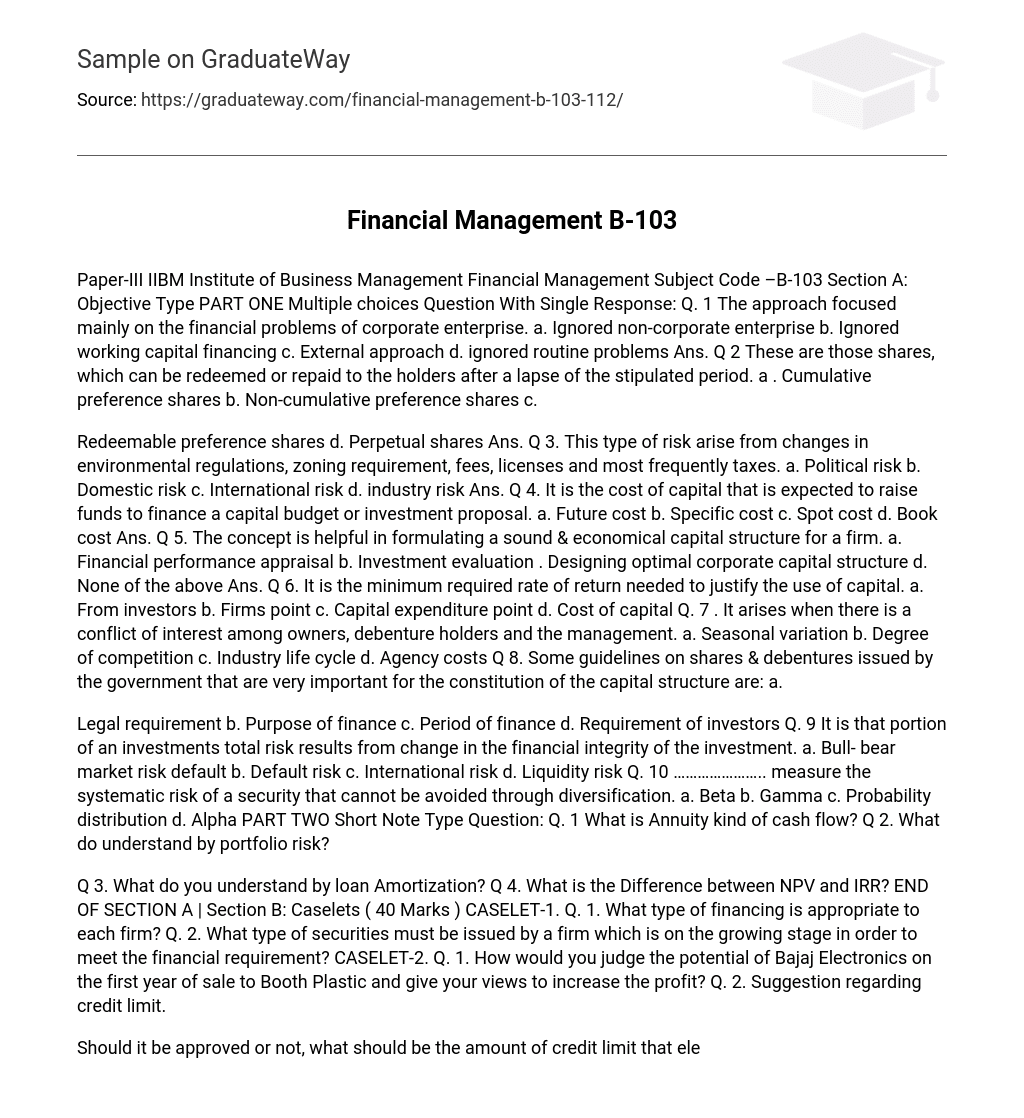Paper-III IIBM Institute of Business Management Financial Management Subject Code –B-103 Section A: Objective Type PART ONE Multiple choices Question With Single Response: Q. 1 The approach focused mainly on the financial problems of corporate enterprise. a. Ignored non-corporate enterprise b. Ignored working capital financing c. External approach d. ignored routine problems Ans. Q 2 These are those shares, which can be redeemed or repaid to the holders after a lapse of the stipulated period. a . Cumulative preference shares b. Non-cumulative preference shares c.
Redeemable preference shares d. Perpetual shares Ans. Q 3. This type of risk arise from changes in environmental regulations, zoning requirement, fees, licenses and most frequently taxes. a. Political risk b. Domestic risk c. International risk d. industry risk Ans. Q 4. It is the cost of capital that is expected to raise funds to finance a capital budget or investment proposal. a. Future cost b. Specific cost c. Spot cost d. Book cost Ans. Q 5. The concept is helpful in formulating a sound & economical capital structure for a firm. a. Financial performance appraisal b. Investment evaluation . Designing optimal corporate capital structure d. None of the above Ans. Q 6. It is the minimum required rate of return needed to justify the use of capital. a. From investors b. Firms point c. Capital expenditure point d. Cost of capital Q. 7 . It arises when there is a conflict of interest among owners, debenture holders and the management. a. Seasonal variation b. Degree of competition c. Industry life cycle d. Agency costs Q 8. Some guidelines on shares & debentures issued by the government that are very important for the constitution of the capital structure are: a.
Legal requirement b. Purpose of finance c. Period of finance d. Requirement of investors Q. 9 It is that portion of an investments total risk results from change in the financial integrity of the investment. a. Bull- bear market risk default b. Default risk c. International risk d. Liquidity risk Q. 10 ………………….. measure the systematic risk of a security that cannot be avoided through diversification. a. Beta b. Gamma c. Probability distribution d. Alpha PART TWO Short Note Type Question: Q. 1 What is Annuity kind of cash flow? Q 2. What do understand by portfolio risk?
Q 3. What do you understand by loan Amortization? Q 4. What is the Difference between NPV and IRR? END OF SECTION A | Section B: Caselets ( 40 Marks ) CASELET-1. Q. 1. What type of financing is appropriate to each firm? Q. 2. What type of securities must be issued by a firm which is on the growing stage in order to meet the financial requirement? CASELET-2. Q. 1. How would you judge the potential of Bajaj Electronics on the first year of sale to Booth Plastic and give your views to increase the profit? Q. 2. Suggestion regarding credit limit.
Should it be approved or not, what should be the amount of credit limit that electronics give to Booth Plastics. END OF SECTION B | Section C: Applied Theory Q. 1. Honey Well Company is contemplating to liberalize its collection effort. Its present sale are Rs. 10 lakh, its average collection period is 30 days, its expected variable cost to sale ratio is 85 per cent and is bed debt ratio is 5 per cent. The Company‘s cost of capital is 10 per cent and tax are is 40 per cent. He proposed liberalization in collection effort increase sale or Rs. 2 lakh increase average collection period by 15 days, and increases the bad debt ratio to 7 percent. Determine the change in net profit. Q. 2. Explain the concept of working capital. What are the factors which influence which influence the working capital? END OF SECTION C | >>>>>>>>>>>>>>>>>>>>>>>>>>>>>>>>>>>>>>>>>>>>>>>>>>>>>>>>>>>>>>>>>>>>>>>>>>>>>>





